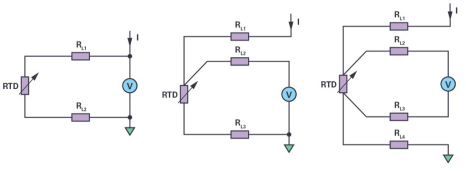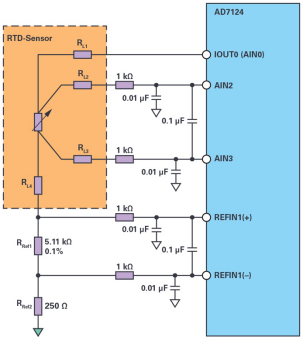“For a wide variety of products, the manufacturing process requires highly accurate and reliable temperature measurement technology. The temperature is usually measured by direct contact with the sensor, for example by immersing the sensor in a liquid or by contacting the surface of the machine. In addition to thermistors and thermocouples, resistance temperature detectors (RTDs) are particularly suitable due to their fast response time and excellent sensitivity of up to several hundred µV/°C. They can also be used for measurements in an ultra-wide range of C200°C to +800°C, and have nearly linear behavior. RTD offers a variety of versions, such as 2-wire, 3-wire or 4-wire version, and has a high degree of application flexibility.
“
Author: Thomas Brand, Field Application Engineer ADI
For a wide variety of products, the manufacturing process requires highly accurate and reliable temperature measurement technology. The temperature is usually measured by direct contact with the sensor, for example by immersing the sensor in a liquid or by contacting the surface of the machine. In addition to thermistors and thermocouples, resistance temperature detectors (RTDs) are particularly suitable due to their fast response time and excellent sensitivity of up to several hundred µV/°C. They can also be used for measurements in an ultra-wide range of C200°C to +800°C, and have nearly linear behavior. RTD offers a variety of versions, such as 2-wire, 3-wire or 4-wire version, and has a high degree of application flexibility.
In order to generate the measurement voltage, the RTD needs an excitation current. Depending on the type of RTD, the voltage level varies from tens to hundreds of mV. The accuracy of the measurement system depends not only on the temperature sensor, but also on the selection of the appropriate measurement instrument, system configuration, and measurement circuit type. Depending on the number of wires, RTD sensors can be used in 2-wire, 3-wire or 4-wire measurement circuits. The comparison of these different measurement circuits is shown in Figure 1.
In the 2-wire measurement circuit, the two wires that provide the excitation current (I) for the RTD are also used to measure the sensor voltage. Because the sensor resistance is very low, even with low wire resistance, RL will produce relatively high measurement inaccuracies. In a 3-wire or 4-wire measurement system, since the sensor excitation occurs through a separate wire, and the measurement wire of the sensor is directly placed on the input end of the measurement device that usually has a high impedance, this error can be minimized.
Unfortunately, due to the low voltage drop across the RTD, the signal is very susceptible to noise. Therefore, the use of long measuring leads should be avoided as much as possible. Noise can be reduced by amplifying the voltage as close as possible to the signal source or RTD. In addition, a sensitive analog-to-digital converter (ADC) with good signal-to-noise ratio (SNR) is suitable for further data processing. ADI’s Σ-Δ ADC, such as the AD7124 series, provides a complete integrated
The 24-bit, low-noise analog front end (AFE) is ideal for high-precision measurement applications. The input can be selectively configured as a differential input or a single-ended/pseudo-differential input. The AD7124 series also integrates digital filters and programmable amplifier stages, making it ideal for low-voltage applications. The circuit shown in Figure 2 is an example of a 4-wire measurement configuration using the AD7124.

Figure 1. Comparison of 2-wire, 3-wire and 4-wire measurements

Figure 2. Configuration of 4-wire RTD temperature measurement using AD7124
The analog pins AIN2 and AIN3 on the AD7124 are configured as differential inputs and used to measure the RTD voltage. The RTD excitation current is drawn from the analog power supply voltage AVDD and provided through AIN0. The excitation current flows through the reference resistor RREF1 at the same time, working as a precision resistor, and then causes the voltage drop detected through the reference pins REFIN1(+) and REFIN1(C). The resulting pressure drop is proportional to the pressure drop across the RTD. This ratiometric configuration ensures that changes in the excitation current have no effect on the overall accuracy of the system. Due to the ADC’s active internal analog buffer, RREF2 will generate the offset voltage required for normal operation. Before analog-to-digital conversion, a buffer is required to filter the readings to provide anti-aliasing characteristics and reduce noise. Alternatively, all analog inputs and reference inputs can be connected to a discrete RC filter. Before starting a simple measurement with the AD7124, calibrate the measurement system (zero-scale and full-scale calibration) to minimize gain and offset errors.
in conclusion
With AFEs such as the AD7124 series, an RTD temperature measurement system can be implemented relatively easily. They provide a very good combination of high accuracy, low power consumption and low noise, suitable for high-precision measurement applications and energy-saving portable devices. In addition, the integration and flexibility of these ADCs simplifies the design architecture and helps shorten the design cycle for measurement applications (for example, temperature, current, voltage, etc.) that use different types of sensors.
About the Author
Thomas Brand joined ADI in Munich, Germany in 2015, when he was still studying for a master’s degree. After graduation, he participated in ADI’s trainee program. In 2017, he became a field application engineer. Thomas provides support to large industrial customers in Central Europe and focuses on the field of industrial Ethernet. He graduated in electrical engineering from the Union University of Education in Mosbach, Germany, and then obtained a master’s degree in international sales from the Konstanz University of Applied Sciences, Germany. Contact information:[email protected]

0 Comments for “Simple implementation of a fully integrated 4-wire RTD temperature measurement system suitable for high-precision measurement applications”